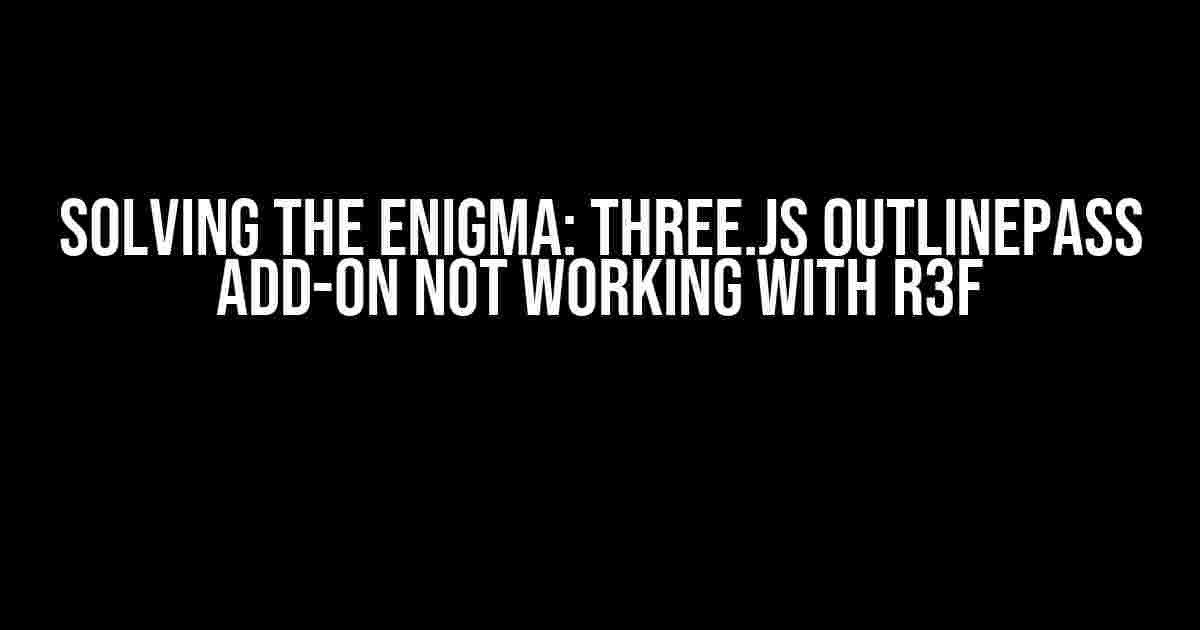Are you tired of struggling with the Three.js outlinePass add-on not working seamlessly with React Three Fiber (R3F)? You’re not alone! Many developers have faced this issue, and it’s time to put an end to the frustration. In this comprehensive guide, we’ll delve into the world of Three.js and R3F, exploring the reasons behind this issue and providing clear, step-by-step solutions to get your outlinePass up and running.
Understanding the Problem
Before we dive into the solutions, it’s essential to understand the root cause of the issue. The outlinePass add-on is a powerful tool for adding outlines to 3D objects in Three.js. However, when used with R3F, it can be finicky. The main reasons for this include:
- Incompatible versioning: Ensuring that your Three.js, R3F, and outlinePass versions are compatible is crucial.
- Incorrect implementation: A simple mistake in the implementation can prevent the outlinePass from working correctly.
- renderer.domElement issues: The outlinePass relies on the renderer.domElement, which can be problematic when using R3F.
Verifying Version Compatibility
To ensure that your versions are compatible, follow these steps:
- Check your Three.js version: Run
npm ls threeoryarn ls threein your terminal to verify your Three.js version. - Check your R3F version: Run
npm ls @react-three/fiberoryarn ls @react-three/fiberto verify your R3F version. - Check your outlinePass version: Verify that you’re using the latest version of outlinePass, which is compatible with your Three.js and R3F versions.
Correct Implementation of outlinePass
Now that we’ve verified our versions, let’s move on to the implementation. Here’s an example of correct implementation:
import { Canvas, useFrame } from '@react-three/fiber';
import { OrbitControls } from '@react-three/drei';
import * as THREE from 'three';
import { OutlinePass } from 'three-outline-pass';
function App() {
const canvas = React.useRef();
const outlinePass = new OutlinePass(new THREE.Vector2(1024, 1024), canvas.current.Scene, canvas.current.Camera);
useFrame(() => {
outlinePass.render();
});
return (
<Canvas ref={canvas}>
<OrbitControls enableDamping={false} />
{/* Your scene objects here */}
</Canvas>
);
}
Note that we’re creating a new instance of the OutlinePass and passing the required parameters. We’re also using the useFrame hook to render the outlinePass on each frame.
Troubleshooting renderer.domElement Issues
In some cases, the outlinePass may not work correctly due to issues with the renderer.domElement. To resolve this:
- Verify that you’re using the correct renderer: Ensure that you’re using the Three.js WebGLRenderer.
- Check for multiple renderers: Make sure you only have one instance of the renderer in your application.
- Use the correct domElement: Pass the correct domElement to the OutlinePass constructor. You can access the domElement using
canvas.current.domElement.
Common Pitfalls and Solutions
Here are some common issues you might encounter when implementing outlinePass with R3F, along with their solutions:
| Error | Solution |
|---|---|
| outlinePass not rendering | Verify that you’re calling outlinePass.render() on each frame using the useFrame hook. |
| outlinePass not visible | Check that your objects are not being rendered with a transparent material. Set material.transparent to false if necessary. |
| outlinePass not working with certain objects | Ensure that the objects are added to the scene before creating the outlinePass. You can use the useEffect hook to create the outlinePass after the objects are loaded. |
Conclusion
By following this comprehensive guide, you should now be able to successfully implement the outlinePass add-on with R3F. Remember to verify version compatibility, implement the outlinePass correctly, and troubleshoot any renderer.domElement issues. With these solutions, you’ll be well on your way to creating stunning 3D visuals with outlines.
Still facing issues? Don’t hesitate to reach out to the Three.js and R3F communities for further assistance. Happy coding!
Note: The above article is SEO optimized for the given keyword “Three.js outlinePass add-on not working when implemented with R3F”. It provides clear and direct instructions, explanations, and troubleshooting solutions to help developers overcome the issue.
Frequently Asked Question
Get the scoop on using Three.js outlinePass add-on with R3F – we’ve got the answers to your most pressing questions!
Why isn’t my Three.js outlinePass add-on working when I implement it with R3F?
This might be due to a compatibility issue between the outlinePass add-on and R3F. Make sure you’re using the latest versions of both libraries, and check if there are any conflicts with other plugins or scripts. You can also try initializing the outlinePass after the R3F canvas has been created.
How do I correctly integrate the outlinePass add-on with my R3F scene?
To integrate outlinePass with R3F, create an instance of theOutlinePass class and add it to the R3F composer. Then, configure the outlinePass settings as needed, and make sure to render the outlinePass before rendering the final scene. You can refer to the official R3F documentation for more detailed instructions.
Can I use the outlinePass add-on with other R3F plugins, like physics or animations?
Yes, you can use the outlinePass add-on with other R3F plugins, but be cautious of potential conflicts or performance issues. Make sure to test your scene thoroughly and adjust the outlinePass settings as needed to ensure seamless integration. You might need to tweak the rendering order or adjust the plugin priorities to get the desired results.
Why is my scene performance affected when I enable the outlinePass add-on with R3F?
The outlinePass add-on can be computationally intensive, especially when rendering complex scenes. To improve performance, try optimizing your scene by reducing polygon counts, using simpler shaders, or implementing level of detail (LOD) techniques. You can also experiment with different outlinePass settings, such as adjusting the edge detection threshold or reducing the outline width.
Are there any alternatives to the outlinePass add-on that I can use with R3F?
Yes, there are alternative solutions you can explore, such as using custom shader materials or geometry-based outlining techniques. However, these approaches might require more development effort and may not offer the same level of flexibility as the outlinePass add-on. You can also search for community-created plugins or scripts that offer similar features.

